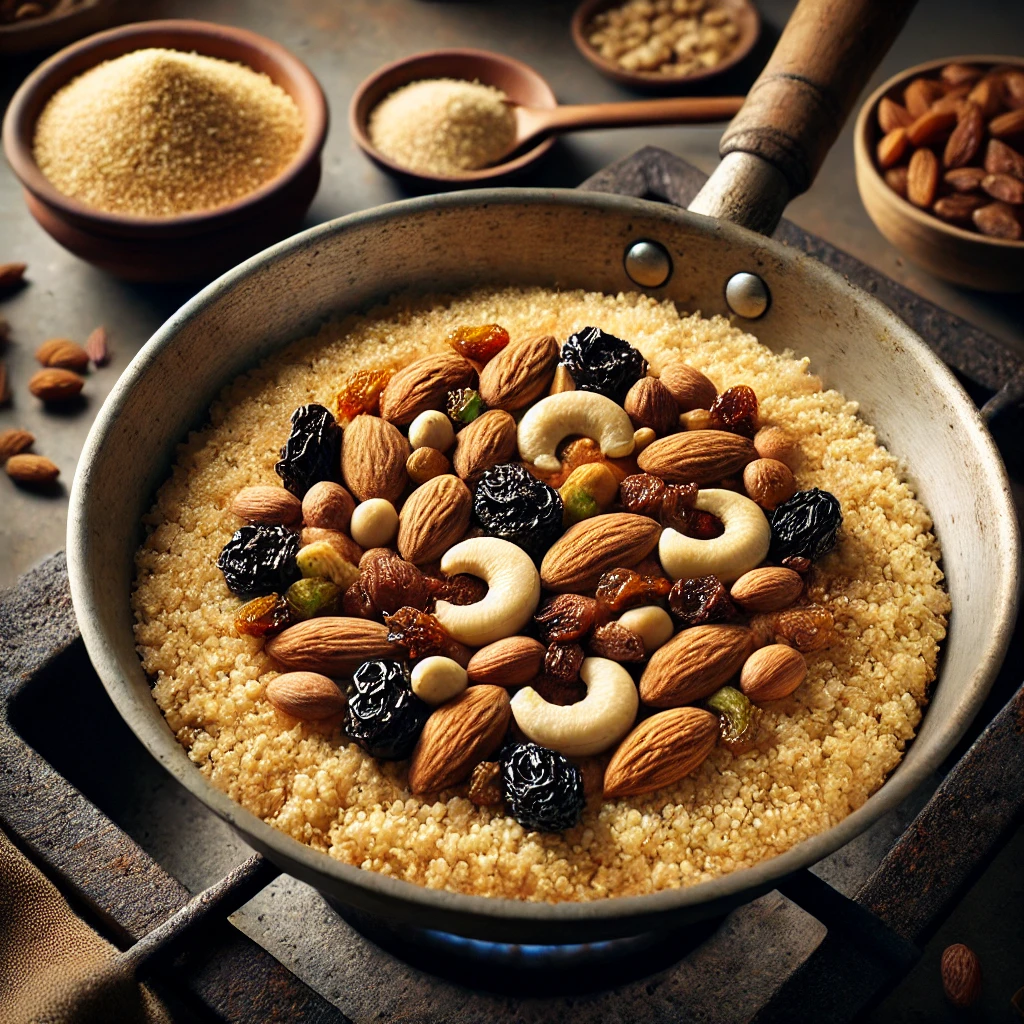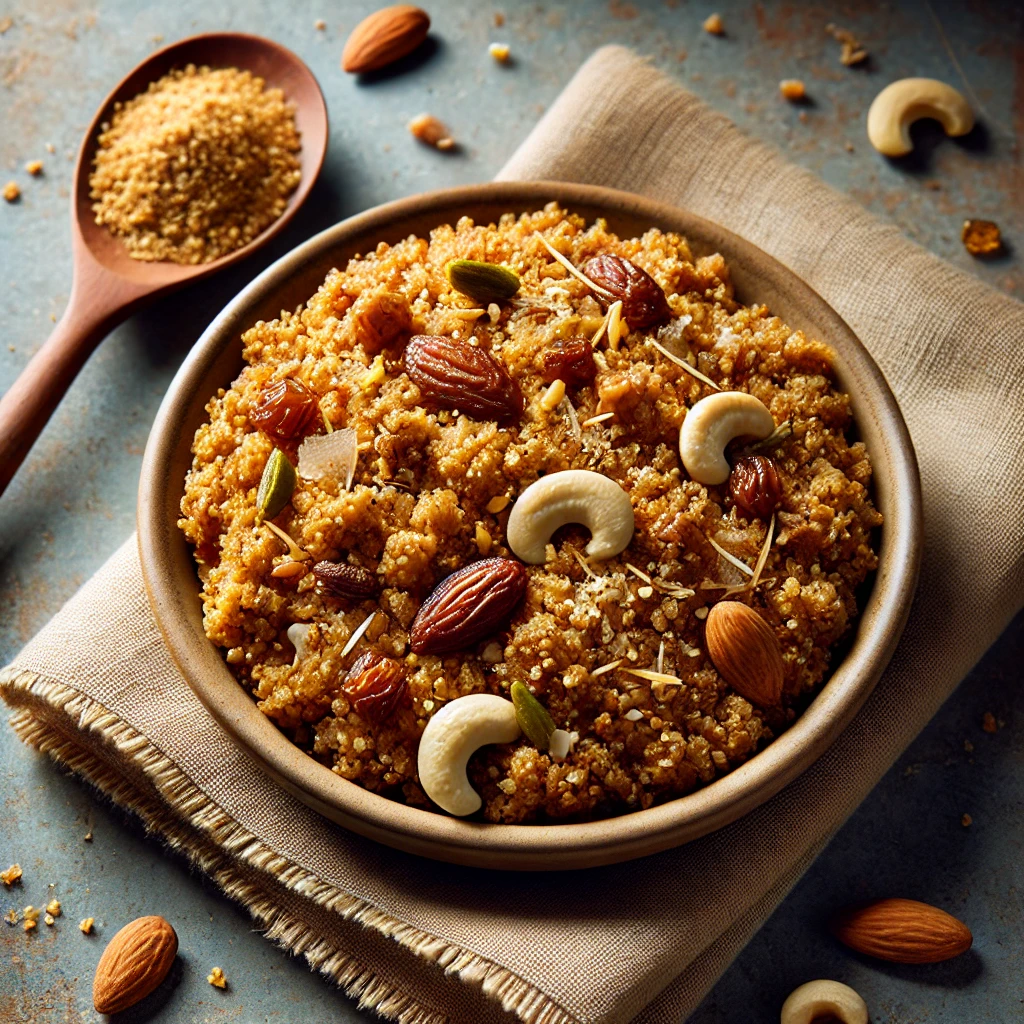Panjeeri is a beloved South Asian delicacy often associated with postpartum care. However, its benefits extend far beyond the postpartum period. For mothers, panjeeri represents a rich cultural tradition packed with nutritional value.
This all-you-need-to-know guide explores what panjeeri is, how it’s made, its ingredients, benefits, and usage for different stages of life.
Table of Contents
What is Panjeeri?
Panjeeri is a nutrient-dense traditional Pakistani and Indian food, typically made with whole wheat flour, ghee, nuts, seeds, and a mix of aromatic spices. It is a health-boosting superfood, especially for postpartum women, but it can be beneficial for you and your family as well. The dish is known for its warming properties and its ability to provide sustained energy and nourishment.
Ingredients of Panjeeri and their nutritional value
The richness of panjeeri comes from its thoughtfully selected ingredients, each contributing unique benefits:
- Whole wheat flour (atta) – Provides essential carbohydrates for energy.
- Ghee – Aids digestion and provides healthy fats.
- Almonds – Rich in Vitamin E and good fats for skin and brain health.
- Walnuts – Packed with Omega-3 fatty acids to support heart and brain health.
- Pistachios – Provide protein and antioxidants to combat oxidative stress.
- Dried coconut (grated) – Offers healthy fats and improves energy levels.
- Fox nuts (makhana) – A great source of protein and calcium.
- Edible gum (gond) – Known for its lactation-boosting and joint-strengthening properties.
- Flaxseeds – Loaded with fiber and Omega-3 fatty acids.
- Fennel seeds – Improves digestion and reduces bloating.
- Jaggery (gur) or sugar – Acts as a natural sweetener and source of iron.
- Cardamom powder – Adds flavor and aids in digestion.
These ingredients combine to create a balanced, nutrient-rich food that supports your overall health.
How is Panjeeri made?
The preparation of panjeeri involves roasting and mixing various ingredients to create a flavorful and nutrient-packed powder. While recipes vary slightly between families, the basic process is as follows:
Preparation steps:
- Heat ghee in a large pan and roast edible gum until it puffs up. Set aside.
- Roast makhana, nuts, and seeds in ghee separately until golden and aromatic.
- Grind the roasted ingredients into a coarse powder.
- Roast whole wheat flour in ghee until it turns golden brown and emits a nutty aroma.
- Mix all the roasted and ground ingredients together in a large bowl.
- Add jaggery or sugar and cardamom powder, stirring well to combine.
- Allow the mixture to cool and store in an airtight container.

Top 7 health benefits of Panjeeri
Panjeeri is a powerhouse of essential nutrients, making it an ideal choice for expectant and postpartum mothers. Here’s what it offers:
1. Energy Booster
Panjeeri’s high-calorie content provides sustained energy, especially important for you if you’re recovering from childbirth.
2. Bone Strength
Rich in calcium from nuts and seeds, panjeeri supports bone health for mothers and growing children.
3. Aids Lactation
Certain ingredients, like fennel seeds and edible gum, are believed to boost milk production in breastfeeding mothers.
4. Improves Digestion
Ingredients like flaxseeds and fennel seeds promote healthy digestion and prevent constipation.
5. Enhances Immunity
Packed with antioxidants from nuts and seeds, panjeeri helps strengthen your immune system.
6. Supports Postpartum Recovery
Foods that accelerate healing during postpartum are backed by science, and panjeeri’s ingredients align with this knowledge. The healthy fats, proteins, and antioxidants it contains reduce inflammation, support tissue repair, and replenish energy.
When and how to use Panjeeri
For postpartum mothers:
Traditionally, panjeeri is consumed during the first 40 days postpartum to aid recovery, boost energy, and improve milk production.
For expectant mothers:
While panjeeri is often considered a postpartum food, you can also consume it during pregnancy in moderation to provide essential nutrients and energy.
For everyone else:
Panjeeri is not limited to new mothers. It’s a healthy snack for anyone needing an energy boost, including children, working professionals, and the elderly.
Recommended serving size:
Start with 2-3 tablespoons a day, either as a snack or mixed into warm milk.
How to use panjeeri
- Incorporate into desserts: Crumble panjeeri over yogurt, kheer, or other desserts for added flavor and nutrition.
- Enjoy as a snack: Have a small portion (1-2 tablespoons) of panjeeri as a mid-morning or evening snack.
- Add to milk: Mix a spoonful of panjeeri with warm milk for a nourishing drink.
How to store Panjeeri to keep it fresh
To ensure panjeeri remains fresh and flavorful:
- Store in an airtight container.
- Keep in a cool, dry place away from direct sunlight.
- For extended shelf life, refrigerate or freeze in small, pre-portioned servings.
FAQs about Panjeeri
1. Is panjeeri safe during pregnancy?
Yes, panjeeri can be consumed during pregnancy in moderation. However, consult your doctor if you have specific dietary restrictions.
2. Can panjeeri be eaten in summers?
Yes, but consume smaller portions as it is considered a “warming” food and may increase body heat.
3. Can children eat panjeeri?
Absolutely! Panjeeri is a nutritious snack for growing children, but reduce the portion size for younger kids.
4. Does panjeeri help with weight gain?
Panjeeri is calorie-dense and can contribute to healthy weight gain if consumed regularly.
5. Can diabetic individuals eat panjeeri?
Diabetic individuals should opt for sugar-free versions and consult their doctor before consumption.
6. Is panjeeri only for postpartum women?
No, this is a myth. While panjeeri is traditionally associated with postpartum care, its benefits make it suitable for people of all ages.
7. Does panjeeri cause excessive weight gain?
This is also a myth. When consumed in moderation, panjeeri provides balanced nutrition without leading to unhealthy weight gain.
8. Is panjeeri unhealthy because it is calorie-dense?
Not at all! The calories in panjeeri come from nutrient-rich ingredients, making it a healthy energy source when eaten in moderation.
Precautions
- Allergies: Check for nut or seed allergies before consuming.
- Portion Control: Avoid overconsumption, as panjeeri is calorie-dense.
- Consult a Doctor: Pregnant or diabetic individuals should consult their doctor before adding panjeeri to their diet.
Final Thoughts
Panjeeri is a timeless, nutrient-packed delicacy that offers immense health benefits for you as an urban Pakistani mother and beyond. Whether you’re recovering postpartum, nourishing your body during pregnancy, or simply looking for a wholesome snack, panjeeri is a versatile choice.
How do you make or enjoy panjeeri in your household? Share your favorite recipes or tips in the comments below, and don’t forget to share this guide with friends and family!
